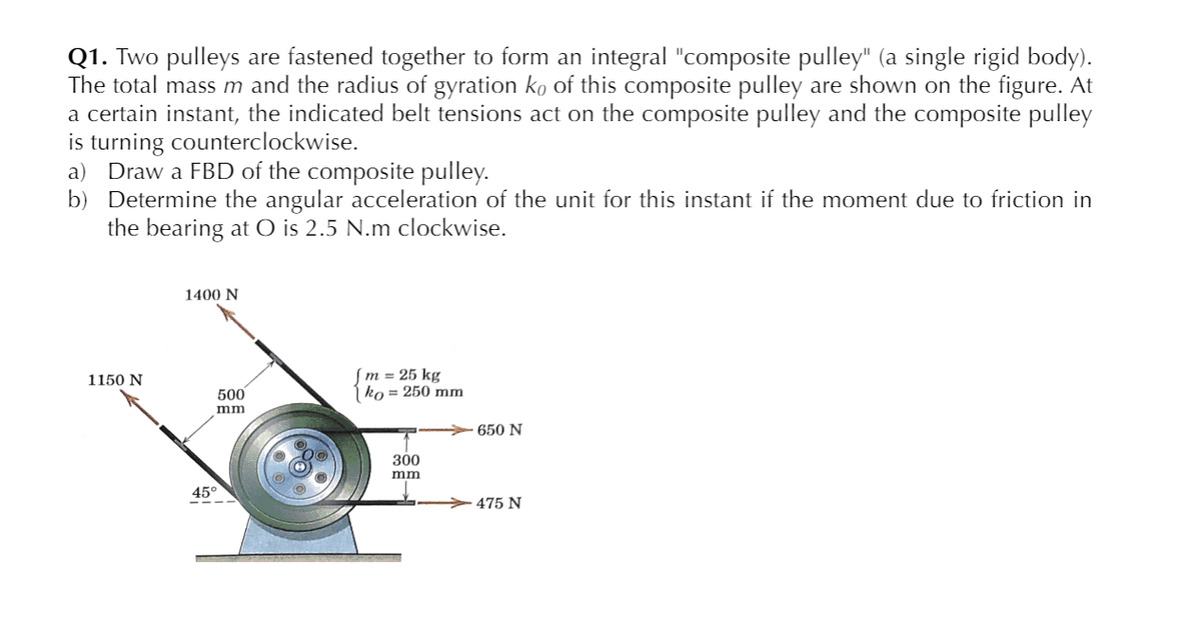Q1. Two pulleys are fastened together to form an integral "composite pulley" (a single rigid body). The total mass m and the radius of gyration ko of this composite pulley are shown on the figure. At a certain instant, the indicated belt tensions act on the composite pulley and the composite pulley is turning counterclockwise. a) Draw a FBD of the composite pulley. b) Determine the angular acceleration of the unit for this instant if the moment due to friction in the bearing at O is 2.5 N.m clockwise. 1400 N |m = 25 kg ko = 250 mm 1150 N 500 mm 650 N 300 mm 45° 475 N
Q1. Two pulleys are fastened together to form an integral "composite pulley" (a single rigid body). The total mass m and the radius of gyration ko of this composite pulley are shown on the figure. At a certain instant, the indicated belt tensions act on the composite pulley and the composite pulley is turning counterclockwise. a) Draw a FBD of the composite pulley. b) Determine the angular acceleration of the unit for this instant if the moment due to friction in the bearing at O is 2.5 N.m clockwise. 1400 N |m = 25 kg ko = 250 mm 1150 N 500 mm 650 N 300 mm 45° 475 N
Elements Of Electromagnetics
7th Edition
ISBN:9780190698614
Author:Sadiku, Matthew N. O.
Publisher:Sadiku, Matthew N. O.
ChapterMA: Math Assessment
Section: Chapter Questions
Problem 1.1MA
Related questions
Question
Please help. This problem involves finding the angular acceleration of a composite pulley. Thank you.

Transcribed Image Text:Q1. Two pulleys are fastened together to form an integral "composite pulley" (a single rigid body).
The total mass m and the radius of gyration ko of this composite pulley are shown on the figure. At
a certain instant, the indicated belt tensions act on the composite pulley and the composite pulley
is turning counterclockwise.
a) Draw a FBD of the composite pulley.
b) Determine the angular acceleration of the unit for this instant if the moment due to friction in
the bearing at O is 2.5 N.m clockwise.
1400 N
|m = 25 kg
ko = 250 mm
1150 N
500
mm
650 N
300
mm
45°
475 N
Expert Solution
This question has been solved!
Explore an expertly crafted, step-by-step solution for a thorough understanding of key concepts.
This is a popular solution!
Trending now
This is a popular solution!
Step by step
Solved in 2 steps with 2 images

Knowledge Booster
Learn more about
Need a deep-dive on the concept behind this application? Look no further. Learn more about this topic, mechanical-engineering and related others by exploring similar questions and additional content below.Recommended textbooks for you

Elements Of Electromagnetics
Mechanical Engineering
ISBN:
9780190698614
Author:
Sadiku, Matthew N. O.
Publisher:
Oxford University Press

Mechanics of Materials (10th Edition)
Mechanical Engineering
ISBN:
9780134319650
Author:
Russell C. Hibbeler
Publisher:
PEARSON

Thermodynamics: An Engineering Approach
Mechanical Engineering
ISBN:
9781259822674
Author:
Yunus A. Cengel Dr., Michael A. Boles
Publisher:
McGraw-Hill Education

Elements Of Electromagnetics
Mechanical Engineering
ISBN:
9780190698614
Author:
Sadiku, Matthew N. O.
Publisher:
Oxford University Press

Mechanics of Materials (10th Edition)
Mechanical Engineering
ISBN:
9780134319650
Author:
Russell C. Hibbeler
Publisher:
PEARSON

Thermodynamics: An Engineering Approach
Mechanical Engineering
ISBN:
9781259822674
Author:
Yunus A. Cengel Dr., Michael A. Boles
Publisher:
McGraw-Hill Education

Control Systems Engineering
Mechanical Engineering
ISBN:
9781118170519
Author:
Norman S. Nise
Publisher:
WILEY

Mechanics of Materials (MindTap Course List)
Mechanical Engineering
ISBN:
9781337093347
Author:
Barry J. Goodno, James M. Gere
Publisher:
Cengage Learning

Engineering Mechanics: Statics
Mechanical Engineering
ISBN:
9781118807330
Author:
James L. Meriam, L. G. Kraige, J. N. Bolton
Publisher:
WILEY